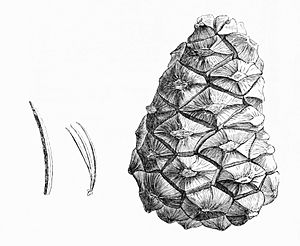Orizaba pinyon facts for kids
Quick facts for kids Orizaba pinyon |
|
|---|---|
 |
|
| Conservation status | |
| Scientific classification | |
| Genus: |
Pinus
|
| Species: |
orizabensis
|
| Synonyms | |
|
|
The Orizaba pinyon (scientific name: Pinus orizabensis) is a special type of pine tree. It belongs to a group called pinyon pines. This tree is found only in a specific part of central Mexico.
Some people think it's a separate species. Others believe it's a subspecies of another pine, Pinus cembroides. It's known for having bigger seeds than other similar pines.
You can find the Orizaba pinyon in a small area. This area is in the eastern part of the Trans-Mexican Volcanic Belt. It grows in the Mexican states of Puebla and Veracruz. These trees like high places, usually between 2,200 and 2,800 meters (about 7,200 to 9,200 feet) above sea level. They prefer cooler and wetter weather than other pinyon pines.
Contents
About the Orizaba Pinyon Tree
This pine is a small to medium-sized tree. It can grow to be 8 to 10 meters (about 26 to 33 feet) tall. Its trunk can be up to 50 centimeters (about 20 inches) wide. The bark is dark brown and thick. It has deep cracks, especially near the bottom of the trunk.
The leaves are like needles, as you'd expect from a pine. They grow in small bundles of three or four needles together. Each needle is thin and about 3 to 6 centimeters (1 to 2.5 inches) long. They are a deep green or blue-green color. If you look closely, you'll see bright white lines on the inside of the needles. These lines are where the tree "breathes" through tiny pores called stomata.
Pine Cones and Seeds
The pine cones of the Orizaba pinyon are round or egg-shaped. They are about 4 to 7 centimeters (1.5 to 2.5 inches) long. When closed, they are 3 to 5 centimeters (1 to 2 inches) wide. At first, they are green. After about 16 to 18 months, they turn yellow-brown when they are ready.
These cones have only a few thin scales, usually 6 to 18 fertile ones. When the cones are mature, they open up to 5 to 7 centimeters (2 to 2.5 inches) wide. The seeds stay on the scales even after the cones open.
The seeds are quite large, about 12 to 15 millimeters (half an inch) long. They have a thick shell and a pink inside part called an endosperm. There's also a tiny wing, only about 2 millimeters long, that doesn't help them fly far.
How Seeds Travel
The seeds are spread by a bird called the Mexican jay. This bird loves to eat the seeds. It pulls them out of the open cones. The Mexican jay stores many seeds to eat later. Some of these stored seeds are never eaten. These forgotten seeds can then grow into new Orizaba pinyon trees. This is a great way for the tree to spread its young!
Discovery and Relationships
The Orizaba pinyon is one of the most recently discovered pinyon pines. It was found by a scientist named Dana K. Bailey in 1983. He was studying an unusual pinyon tree growing at the Royal Botanic Gardens, Kew in England. He realized it matched wild trees from the Pico de Orizaba area in Mexico.
At first, it was thought to be a subspecies of the Mexican pinyon. But more research showed it was different enough to be its own species. Even though some scientists still group it with the Mexican pinyon, these two trees don't mix or create hybrids when they grow together.
The Orizaba pinyon grows better in rainy, mild climates like England. The Mexican pinyon prefers drier places.
The Orizaba pinyon is closely related to Johann's pinyon and Potosi pinyon. All three have needles with white lines on the inner surfaces. However, the Orizaba pinyon has larger cones and seeds. It also has fewer needles per bundle (3-4) than the Potosi pinyon (which has 5).
Because of its attractive blue-green needles, the Orizaba pinyon makes a beautiful small tree. It's often planted in parks and large gardens. People in Mexico also collect its edible seeds, which are known as pine nuts.


